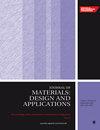探索纤维取向对香蕉和玉米纤维增强聚合物复合材料机械特性的影响
IF 2.2
4区 材料科学
Q3 MATERIALS SCIENCE, MULTIDISCIPLINARY
Proceedings of the Institution of Mechanical Engineers, Part L: Journal of Materials: Design and Applications
Pub Date : 2024-07-23
DOI:10.1177/14644207241260662
引用次数: 0
摘要
近几十年来,天然纤维增强聚合物复合材料因其耐用性、环保性和良好的复合材料性能而得到了广泛应用。本研究探讨了单向和横向纤维取向对香蕉纤维和玉米纤维增强聚合物复合材料机械性能的影响,这些复合材料是通过手糊工艺制作而成的。研究评估了纤维取向对各种机械性能的影响,包括密度、孔隙率、拉伸强度、弯曲强度和冲击强度。研究结果表明,与环氧树脂基体相比,香蕉纤维和玉米纤维的密度更高,这有助于增加复合材料的总体重量密度,而交叉方向的纤维取向会导致孔隙率增加。此外,横向纤维取向还能增强拉伸强度,从而与基体形成牢固的粘结。横向玉米纤维复合材料的极限拉伸强度最高,达到 49.57 兆帕,与其他纤维配置相比有显著提高。值得注意的是,单向玉米纤维的抗弯强度为 14.07 兆帕,分别比香蕉-玉米和香蕉-香蕉结构的抗弯强度高出 268.32% 和 32.73%,而香蕉-玉米交叉方向混合复合材料由于具有抗裂纹扩展的能力,抗冲击强度达到 5.31 kJ/m2。这些见解为复合材料的设计和应用提供了宝贵的指导。本文章由计算机程序翻译,如有差异,请以英文原文为准。
Exploring the influence of fiber orientation on the mechanical characteristics of polymer composites reinforced with banana and corn fibers
In recent decades, the utilization of polymer composites reinforced with natural fibers has seen a significant increase due to their durability, eco-friendliness, and favorable composite properties. This study investigates the influence of unidirectional and cross-directional fiber orientation on the mechanical properties of polymer composites reinforced with banana and corn fibers, fabricated through a hand-lay-up process. The research assesses the impact of fiber orientation on various mechanical properties, including density, porosity, tensile strength, flexural strength, and impact strength. The findings reveal that the higher densities of banana and corn fibers, in comparison to the epoxy matrix, contribute to increased overall weight density in the composites, with cross-directional fiber orientation leading to higher porosity. Moreover, cross-directional reinforcement orientation enhances tensile strength, resulting in a robust bond with the matrix. Composites with cross-directional corn fibers exhibit the highest ultimate tensile strength of 49.57 MPa, marking a significant improvement over other fiber configurations. Notably, unidirectional corn fibers outperform in flexural strength of 14.07 MPa, surpassing banana–corn, and banana–banana configurations by 268.32% and 32.73%, respectively, and cross-directional banana–corn hybrid composites exhibit superior impact strength measuring 5.31 kJ/m2 due to their ability to resist crack propagation. Whereas scanning electron microscopy micrographs of fractured samples reveal debonding, fiber pullout, and fiber scissoring as the root causes of sample failure under tensile load These insights provide valuable guidance for the design and application of composite materials.
求助全文
通过发布文献求助,成功后即可免费获取论文全文。
去求助
来源期刊

CiteScore
4.70
自引率
8.30%
发文量
166
审稿时长
3 months
期刊介绍:
The Journal of Materials: Design and Applications covers the usage and design of materials for application in an engineering context. The materials covered include metals, ceramics, and composites, as well as engineering polymers.
"The Journal of Materials Design and Applications is dedicated to publishing papers of the highest quality, in a timely fashion, covering a variety of important areas in materials technology. The Journal''s publishers have a wealth of publishing expertise and ensure that authors are given exemplary service. Every attention is given to publishing the papers as quickly as possible. The Journal has an excellent international reputation, with a corresponding international Editorial Board from a large number of different materials areas and disciplines advising the Editor." Professor Bill Banks - University of Strathclyde, UK
This journal is a member of the Committee on Publication Ethics (COPE).
 求助内容:
求助内容: 应助结果提醒方式:
应助结果提醒方式:


